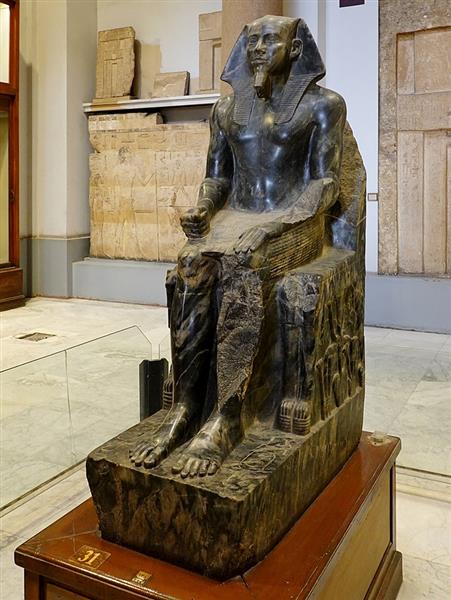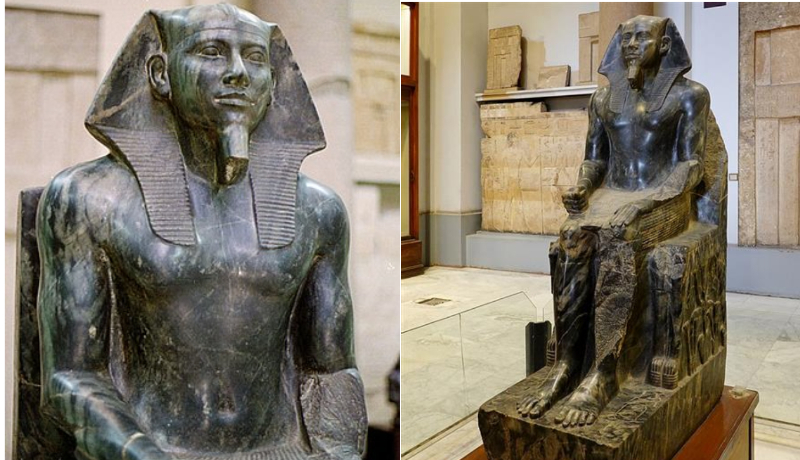A funeral statue of Pharaoh Khafre, who ruled over ancient Egypt’s Fourth dynasty, is known as Khafre Enthroned (c. 2570 BC). It is now housed in Cairo’s Egyptian Museum.
Significance of The Khafre Enthroned Sculpture
Anorthosite gneiss, a valuable, extremely hard, and dark stone brought 400 miles down the Nile River from royal quarries, is used in the construction. It is related to diorite. This emphasizes the significance and authority of Khafre as a leader. The statue was created for the Pharaoh’s valley temple, which is a part of the necropolis—a funerary city—used for funeral rites—and is located close to the Great Sphinx. For the Pharaoh’s ka—the life energy that accompanied a person with a sense of the other self—these Old Kingdom statues served a crucial purpose in Egyptian tombs. The ka departs from the body after death and enters the afterlife, but they still require a place to rest, which is the statue.

Khafre is shown seated in this sculpture, which is an in-the-round (as opposed to relief) representation of the human figure from the Old Kingdom. The 70-day process of mummification, which was used to ensure the pharaoh’s immortality, was extremely important to Egyptian society. A ka statue was made in the third millennium BCE to “guarantee immortality and permanence of the deceased’s identity by providing an alternative dwelling place for the ka” in the event that the pharaoh’s mummy was damaged.
Khafre sternly reclines in his throne and stares into the horizon. The pharaoh’s head is mostly covered by a linen nemes headdress that folds over his broad shoulders. The uraeus, or cobra, emblem and the royal fake beard connected to the end of his chiseled chin are both depicted on the front of this royal headgear, exemplifying his monarchy and divinity. Khafre displays his perfect upper physique and well-defined muscles while wearing a kilt around his waist. This representation, which makes use of Egyptian artistic standards including a pristine body, an ageless face, and ideal body proportions, is not a portrait but rather a representation of Khafre’s authority.
Egyptian idealized portraits declare the divine character of Egyptian rule rather than capturing particular attributes. Khafre sits atop a throne made of the bodies of two stylised lions, which also serve as the base. The unification of Upper and Lower Egypt, which brought an end to the Egyptian Pre-Dynastic period, is symbolized by the papyrus and lotus plants that grow between the legs of the throne. Another allusion to undivided Egypt is the falcon-like representation of the god Horus guarding the rear of Khafre’s head.
In addition to the impressive sight of the falcon perched behind Khafre’s head (unseen from the front), Khafre’s feet are set onto a flat platform that is etched with nine archery bows, which stand for the monarch and kingdom’s dominance over foreign and internal enemy tribes.
Khafre is timeless, and his power will endure even after death. The symmetrical pharaoh exhibits no movement or change, suppressing all motion and time to create an eternal stillness. His powerful build and unchanging stance also dispel any notion of time. The pharaoh’s impassive and timeless visage is a reference to his non-chaotic, controlled empire and strong leadership; the pharaoh is in charge of his dominion.
The statue is built with few protruding components and is compact and solid; Khafre’s block-like body is fixed to the throne to stay forever, forming one single construction. He is in a tight, frontal position with his arms resting on his thighs. The statue, which is bilaterally symmetric and represents order and control in the pharaoh, is identical on both sides of its vertical axis save for Khafre’s clinched right fist. In order to protect his ka, Khafre is shown as a perpetual creature with a close profile and a block-like appearance. Both here on Earth and in the afterlife, Khafre will always exist.
The pharaoh’s statue exhibits the traits of an Egyptian block statue: it is completely frontal, completely immovable, and flawlessly tranquil.











